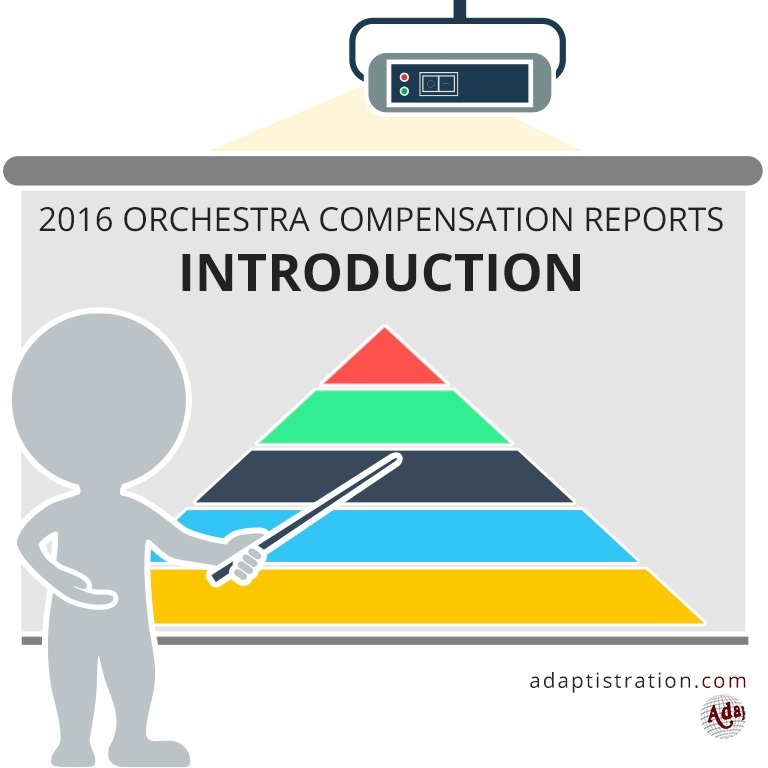The final installment of the 2008 Orchestra Compensation Reports will examine compensation levels for concertmasters…
WHO IS THIS CONCERTMASTER PERSON?
For those not already familiar with the concertmaster position, this is the title reserved for the principal seat within the 1st violin section. More often than not, this is the musician you see walking out on stage at the beginning of the concert to initiate the orchestra’s tuning process before the conductor emerges.
Although concertmasters are included within every orchestra’s collective bargaining agreement, they also negotiate a separate contract with the orchestra detailing compensation and additional duties exclusive to their position. For example, it isn’t uncommon for a concertmaster to be featured as a soloist with their orchestra at least once a year. As such, their annual income will fluctuate based on the number of solo appearances they negotiate with their organization.
Additionally, concertmasters are required to perform any of the numerous internal solos incorporated into any given piece of music (such as the famous violin solo from Scheherazade). Beyond actual performing duties, concertmasters (along with other principal seat string musicians) are usually required to perform some additional duties such as bowings. Bowings are markings placed throughout a string player’s sheet music that indicate which direction to move the bow. This allows each section of strings to move their bows in unison and enhance to the sense of phrasing a conductor wishes to use.
A common perk associated with many concertmaster personal contracts are clauses excluding them from having to perform during some non-masterwork oriented concerts (such as holiday, pops, or educational
concerts). As this clause is not uniform, the frequency and type of concerts concertmasters are excluded from participating in vary from one musician to the next. It is also one of the reasons why orchestras may have one or two additional violinists within the orchestra who serve under the title of associate or assistant concertmaster.
Regardless of the additional clauses a concertmaster negotiates in their personal contract, they are afforded the same base workplace protection and representation guaranteed all musicians under the organization’s collective bargaining agreement.
WHERE THE NUMBERS COME FROM
All data presented in these reports coincide with the corresponding documentation from the 2005/06 season. In order to provide information that is as accurate as possible, data for the 2005/06 season is gathered from the following sources:
- Concertmaster compensation figures were obtained from their respective orchestra’s IRS Form 990.
- Total Ensemble Expenditures were also obtained from each respective orchestra’s IRS Form 990.
- Base Musician compensation figures were obtained from compensation records collected by the American Federation of Musicians and International Guild of Symphonic, Opera, and Ballet Musicians (IGSOBM).
Adaptistration makes no claim to the accuracy of information from documents compiled or reported by external sources. If you have reason to believe any of the information is inaccurate or has changed since reported in any of the above sources and you can provide documentation to such effect, please feel free to send in a notice.
WHAT THE NUMBERS DON’T SHOW
It is important to remember that the numbers shown do not always convey a complete compensation picture. For example, a concertmaster may have had a large increase in salary because they had twice the number of featured solo appearances for this season compared to last. Likewise, they may have
left the position after the 2005/06 season and, per terms of their individual contract, received a sizeable severance or deferred compensation package. As such, the cumulative compensation reported
under those conditions may artificially inflate or reduce annual earnings.
The “Base Musician” compensation figures do not include any additional payments including but not limited to outreach services and minimum overscale and/or seniority payments, all of which are more common for ICSOM musicians as opposed to their ROPA peers. Finally, these figures do not include any of the opera, ballet, or festival orchestras which are members of ICSOM or IGSOBM.
TOP 10 EARNERS AND QUICK FACTS
2005/06 Quick Facts:
- After a two season dip in average compensation, the average concertmaster earned more than ever before.
- For the first time in the past seven seasons, concertmaster and base musician compensation increased at nearly identical percentages.
WHERE ARE THE ROPA CONCERTMASTER FIGURES?
There are two reasons why the concertmaster compensation figures are not listed in the ROPA installments of the compensation reports. First, the IRS only requires nonprofit organizations to list the top five employees and private contractors paid over $50,000 on their Form 990. Second, because ROPA musicians earn so much less than their ICSOM peers, there are only a few ROPA ensembles that pay their concertmaster enough to warrant including that individual on the Form 990. Furthermore, concertmasters in other ensembles who do earn over $50,000 may not earn enough to be considered in the top five paid employees.
However, there were five concertmasters listed in their respective orchestra’s IRS Form 990, those ensembles were:
- Pacific Symphony paid their concertmaster $130,989.
- Toledo Symphony paid their concertmaster $111,489.
- Richmond Symphony paid their concertmaster $79,653.
- Grand Rapids Symphony paid their concertmaster $78,593.
- Hartford Symphony paid their concertmaster $60,300.




Hi,
My name is Kelly and I am currently a college freshmen enrolled in a music appreciation course at Mitchell Community College in North Carolina. My teacher asked the class today if anyone knew why the concertmaster was always a violin player. Well, no one knew and we were told to find out… so this is my attempt to find out. I am truely sorry to bother you but while surfing the web I came across your site and thought well, they could help.
Thank you for any answer that you have…
Kelly Cahill